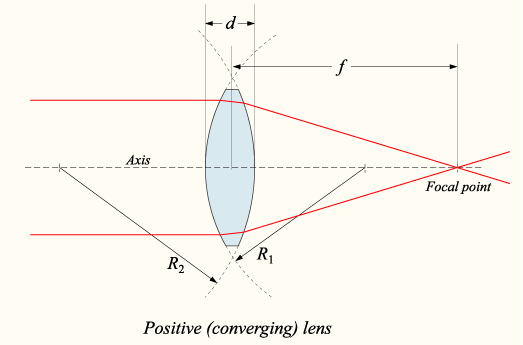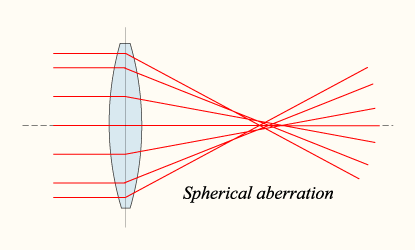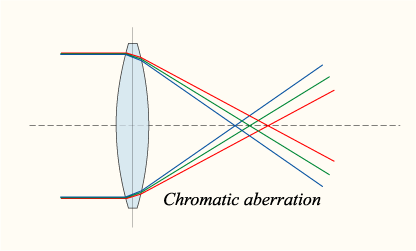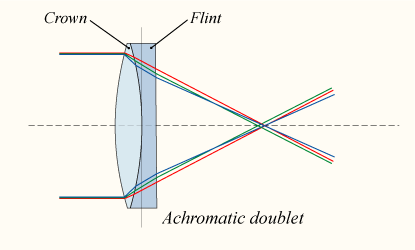Lens (optics)
|
|
A lens is a device for either concentrating or diverging light, usually formed from a piece of shaped glass. Analogous devices used with other types of electromagnetic radiation are also called lenses: for instance, a microwave lens can be made from paraffin wax.
The earliest records of lenses date to Ancient Greece, with Aristophanes' play The Clouds (424 BC) mentioning a burning-glass (a convex lens used to focus the sun's rays to produce fire). The writings of Pliny the Elder (23-79) also show that burning-glasses were known to the Roman Empire, and mentions what is possibly the first use of a corrective lens: Nero was known to watch the gladiatorial games through a concave-shaped emerald (presumably to correct for myopia). Seneca the Younger (3 BC--65) described the magnifying effect of a glass globe filled with water. The Arabian mathematician Alhazen (Abu Ali al-Hasan Ibn Al-Haitham), (965-1038) wrote the first major optical treatise which described how the lens in the human eye formed an image on the retina. Widespread use of lenses did not occur until the invention of spectacles, probably in Italy in the 1280s.
| Contents |
Lens construction
The most common type of lenses are spherical lenses, which are formed from surfaces that have spherical curvature, that is, the front and back surfaces of the lens can be imagined to be part of the surface of two spheres of given radii, R1 and R2, which are called the radius of curvature of each surface. The sign of R1 gives the shape of the front surface of the lens: if R1 is positive, the surface is convex (bulging outwards from the lens). If R1 is negative, the front surface is concave (bulging into the lens). If R1 is infinite, the surface is flat, or has zero curvature, and is said to be plane. The same is true for the back surface of the lens, except that the sign conversion is reversed: if R2 is positive, it is concave, and if R2 is negative,the back surface is convex. The line joining the centres of the spheres making up the lens surfaces is called the axis of the lens; in almost all cases the lens axis passes through the physical centre of the lens.
Missing image
Lens2.png
image:lens2.png
Lenses are classified by the curvature of these two surfaces. A lens is biconvex (or just convex) if both surfaces are convex, likewise, a lens with two concave surfaces is biconcave (or concave). If one of the surfaces is flat, the lens is termed plano-convex or plano-concave depending on the curvature of the other surface. A lens with one convex and one concave side is termed convex-concave, and in this case if both curvatures are equal it is a meniscus lens. (Sometimes, all lenses of the convex-concave type are called meniscus lenses.)
If the lens is biconvex or plano-convex, a collimated or parallel beam of light passing along the lens axis and through the lens will be converged (or focused) to a spot on the axis, at a certain distance behind the lens (known as the focal length). In this case, the lens is called a positive or converging lens.
If the lens is biconcave or plano-concave, a collimated beam of light passing through the lens is diverged (spread); the lens is thus called a negative or diverging lens. The beam after passing through the lens appears to be emanating from a particular point on the axis in front of the lens; the distance from this point to the lens is also known as the focal length, although it is negative with respect to the focal length of a converging lens.
If the lens is convex-concave, whether it is converging or diverging depends on the relative curvatures of the two surfaces. If the curvatures are equal (a meniscus lens), then the beam is neither converged or diverged.
The value of the focal length f for a particular lens can be calculated from the lensmaker's equation:
- <math>\frac{1}{f} = \left(\frac{n}{n'}-1\right) \left[ \frac{1}{R_1} + \frac{1}{R_2} + \frac{(n-1)d}{n R_1 R_2} \right],<math>
where n is the refractive index of the lens material, n' is the refractive index of the place which the lens is in and d is the distance along the lens axis between the two surfaces (known as the thickness of the lens). If d is small compared to R1 and R2, then the thin lens assumption can be made, and f can be estimated as:
- <math>\frac{1}{f} = \left(\frac{n}{n'}-1\right)\left[ \frac{1}{R_1} + \frac{1}{R_2} \right].<math>
The focal length f is positive for converging lenses, negative for diverging lenses, and infinite for meniscus lenses. The value 1/f is known as the power of the lens, and so meniscus lenses are said to have zero power. Lens power is measured in dioptres, which have units of inverse meters (m−1).
Lenses are also reciprocal; i.e. they have the same focal length when light travels from the front to the back as when light goes from the back to the front (although other properties of the lens, such as the aberration [see below] are not necessarily the same in both directions).
Imaging properties
As mentioned above, a positive or converging lens will focus a collimated beam travelling along the lens axis to a spot (known as the focal point) at a distance f from the lens. Conversely, a point source of light placed at the focal point will be converted into a collimated beam by the lens. These two cases are examples of image formation in lenses. In the former case, an object at an infinite distance (as represented by a collimated beam of light) is focused to an image at the focal point of the lens. In the latter, an object at the focal length distance from the lens is imaged at infinity. The plane perpendicular to the lens axis situated at a distance f from the lens is called the focal plane.
Missing image
Lens3.png
image:lens3.png
If the distances from the object to the lens and from the lens to the image are S1 and S2 respectively, for a lens of negligible thickness they are found by the thin lens formula:
- <math>\frac{1}{S_1} + \frac{1}{S_2} = \frac{1}{f}<math>.
What this means is that, if an object is placed at a distance S1 along the axis in front of a positive lens of focal length f, a screen placed at a distance S2 behind the lens will have an image of the object projected onto it, as long as S1 > f. This is the principle behind photography. The image in this case is known as a real image.
Missing image
Lens3b.png
image:lens3b.png
Note that if S1 < f, S2 becomes negative, and the image is apparently positioned on the same side of the lens as the object. Although this kind of image, known as a virtual image, cannot be projected on a screen, an observer looking through the lens will see the image in its apparent calculated position. A magnifying glass creates this kind of image.
The magnification of the lens is given by:
- <math> M = - \frac{S_2}{S_1} = \frac{f}{f - S_1}<math>,
where M is the magnification factor; if |M|>1, the image is larger than the object. Notice the sign convention here shows that, if M is negative, as it is for real images, the image is upside-down with respect to the object. For virtual images, M is positive and the image is upright.
In the special case that S1 = ∞, we have S2 = f and M = −f / ∞ = 0. This corresponds to a collimated beam being focused to a single spot at the focal point. The size of the image in this case is not actually zero, since diffraction effects place a lower limit on the size of the image (see Rayleigh criterion).
Missing image
Lens4.png
image:lens4.png
The formulas above may also be used for negative (diverging) lens by using a negative focal length (f), but for these lenses only virtual images can be formed.
Aberrations
Lenses do not form perfect images, and there is always some degree of distortion or aberration introduced by the lens which causes the image to be an imperfect replica of the object. Careful design of the lens system for a particular application ensures that the aberration is minimised. There are several different types of aberration which can affect image quality.
Spherical aberration
Spherical aberration is caused because spherical surfaces are not the ideal shape with which to make a lens, but they are by far the simplest shape to which glass can be ground and polished and so are often used. Spherical aberration causes beams parallel to but away from the lens axis to be focused in a slightly different place than beams close to the axis. This manifests itself as a blurring of the image. Lenses in which closer-to-ideal, non-spherical surfaces are used are called aspheric lenses, which are complex to make and often extremely expensive. Spherical aberration can be minimised by careful choice of the curvature of the surfaces for a particular application: for instance, a plano-convex lens which is used to focus a collimated beam produces a sharper focal spot when used with the convex side towards the beam.
Coma
Another type of aberration is coma, which derives its name from the comet-like appearance of the aberrated image. Coma occurs when an object off the optical axis of the lens is imaged, where rays pass through the lens at an angle to the axis θ. Rays which pass through the centre of the lens of focal length f are focused at a point with distance f tan θ from the axis. Rays passing through the outer margins of the lens are focused at different points, either further from the axis (positive coma) or closer to the axis (negative coma). In general, a bundle of parallel rays passing through the lens at a fixed distance from the centre of the lens are focused to a ring-shaped image in the focal plane, known as a comatic circle. The sum of all these circles results in a V-shaped or comet-like flare. As with spherical aberration, coma can be minimised (and in some cases eliminated) by choosing the curvature of the two lens surfaces to match the application. Lenses in which both spherical aberration and coma are minimised are called bestform lenses.
Chromatic aberration
Chromatic aberration is caused by the dispersion of the lens material, the variation of its refractive index n with the wavelength of light. Since from the formulae above f is dependent on n, if follows that different wavelengths of light will be focused to different positions. Chromatic aberration of a lens is seen as fringes of color around the image. It can be minimised by using an achromatic doublet (or achromat) in which two materials with differing dispersion are bonded together to form a single lens. This reduces the amount of chromatic aberration over a certain range of wavelengths, though it does not produce perfect correction. The use of achromats was an important step in the development of the optical microscope. An apochromat is a lens or lens system which minimizes both chromatic and spherical aberrations.
Other kinds of aberration include field curvature, barrel and pincushion distortion, and astigmatism.
Multiple lenses
Lenses may be combined to form more complex optical systems. The simplest case is when lenses are placed in contact: if the lenses of focal lengths f1 and f2 are "thin", the combined focal length F of the lenses can be calculated from:
- <math>\frac{1}{F} = \frac{1}{f_1} + \frac{1}{f_2}<math>.
Since 1/f is the power of a lens, it can be seen that the powers of thin lenses in contact are additive.
Uses of lenses
One important use of lenses is as a prosthetic for the correction of visual impairments such as myopia, hyperopia, presbyopia, and astigmatism. See corrective lens, contact lens, eyeglasses.
Another use is in imaging systems such as a monocular, binoculars, telescope, spotting scope, telescopic gun sight, theodolite, microscope, and camera (photographic lens). A single convex lens mounted in a frame with a handle or stand is a magnifying glass.
Radio astronomy and radar systems often use dielectric lenses, commonly called a lens antenna to refract electromagnetic radiation into a collector antenna. The Square Kilometer Array radio telescope will employ such lenses to get a collection area nearly 30 times greater than what is currently the largest antenna ever built.
See also
- Aberration in optical systems
- Photographic lens
- F-number
- Numerical aperture
- Bokeh
- Telescope
- Microscope
- Eyepiece
- Fresnel lens
- Optical coatings
- Gradient index lens
- History of lensmaking
- Zoom lens
- Gravitational lens
- Dielectric lens
- Lens grinder
External links
- Lens article at digitalartform.com (http://www.digitalartform.com/lenses.htm)
- Thin Lens Java applet (http://www.phy.ntnu.edu.tw/java/Lens/lens_e.html)
- Article on Ancient Egyptian lenses (http://home.comcast.net/~hebsed/enoch.htm)da:Optisk linse
de:Linse (Optik) fr:Lentille optique he:עדשה it:Lente nl:Lens (optisch) ja:レンズ pl:Soczewka ru:Линза (оптика) simple:Lens sv:Lins zh:透镜






